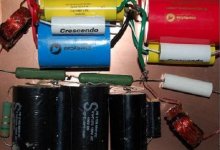Anyone used blank (copper-clad)PCB material upon which to mount components for passive crossover (G10,FR4 or PTFE Cu-Clad boards)??
It seems to be better than the ubiquitous perf-board,and the copper layer makes a nice groundplane on which to anchor the "star-ground" terminal. I've tried this and it seems to work rather well...
Anyone care to point out any pros or cons of such an arrangement?
-chas
It seems to be better than the ubiquitous perf-board,and the copper layer makes a nice groundplane on which to anchor the "star-ground" terminal. I've tried this and it seems to work rather well...
Anyone care to point out any pros or cons of such an arrangement?
-chas
Hi
I don´t think that you need a ground-plane in a passive CO.
One problem could be that a continuous gnd-plane could act as a shorted winding on the inductors? I've never seen any mentioning of this, so maybe I'm wrong.
A piece of wood/MDF would probably work better, be cheaper and stronger.
Regards TroelsM
I don´t think that you need a ground-plane in a passive CO.
One problem could be that a continuous gnd-plane could act as a shorted winding on the inductors? I've never seen any mentioning of this, so maybe I'm wrong.
A piece of wood/MDF would probably work better, be cheaper and stronger.
Regards TroelsM
re:shorted winding on the inductors
TroelsM wrote:
I'm not familiar with this. How does this happen and would this be possible, even when the inductors are mounted vertically, and the copper surface is grounded?
(Attached is a photo of the layout before soldering)
-chas
TroelsM wrote:
One problem could be that a continuous gnd-plane could act as a shorted winding on the inductors?
I'm not familiar with this. How does this happen and would this be possible, even when the inductors are mounted vertically, and the copper surface is grounded?
(Attached is a photo of the layout before soldering)
-chas
Attachments
If Troels is saying that a copper inductor on the copper groundplane could somehow short out the windings on the inductor, that shouldn't happen, but could I suppose. The wire is insulated, so unless the coating is damaged, it shouldn't ground out and short the coils. If your worried about it, use enough glue to make sure the parts don't touch.
I've done this but not because there was an advantage to it. i did it cuz I have a large amount of them I purchased from China, with nothing else to use them for.
Some people feel that resonances can cause noticeable problems, that the resonances could impact the sound. I've only read one scientific article to support this, the new published work and white paper from Clarity Cap, and I'm not fully convinced based on this one report. The methods seem sound, the metrics well thought out, but I'm not fully convinced their methods are adequate to rule out other possibilities. I also saw nothing to imply that they controlled for other changes in the capacitors besides resonance (What if ESL or ESR changes too). Anyway, if this was the case, its possible that a more solid mechanical ground, such as a block of wood, would fix this issue.
I've done this but not because there was an advantage to it. i did it cuz I have a large amount of them I purchased from China, with nothing else to use them for.
Some people feel that resonances can cause noticeable problems, that the resonances could impact the sound. I've only read one scientific article to support this, the new published work and white paper from Clarity Cap, and I'm not fully convinced based on this one report. The methods seem sound, the metrics well thought out, but I'm not fully convinced their methods are adequate to rule out other possibilities. I also saw nothing to imply that they controlled for other changes in the capacitors besides resonance (What if ESL or ESR changes too). Anyway, if this was the case, its possible that a more solid mechanical ground, such as a block of wood, would fix this issue.
mechanical resonances
I've used hot glue to bond (cascaded) clusters of caps together and I imagine that by gooping a bit more (hot glue over the circumference of the cap), you could effectively damp mechanical resonances. Securing components to the board using "zip-ties" can further stabilize them.
-chas
Some people feel that resonances can cause noticeable problems, that the resonances could impact the sound...Anyway, if this was the case, its possible that a more solid mechanical ground, such as a block of wood, would fix this issue.
I've used hot glue to bond (cascaded) clusters of caps together and I imagine that by gooping a bit more (hot glue over the circumference of the cap), you could effectively damp mechanical resonances. Securing components to the board using "zip-ties" can further stabilize them.
-chas
- Status
- This old topic is closed. If you want to reopen this topic, contact a moderator using the "Report Post" button.
